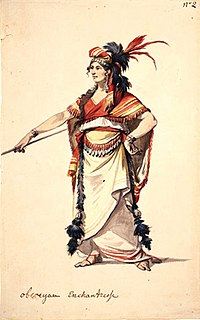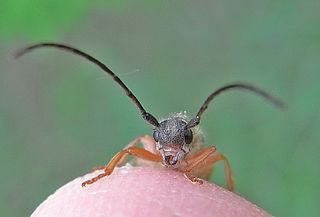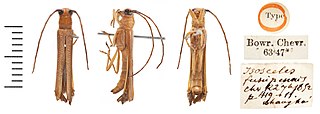Related Research Articles

Purea, Tevahine-'ai-roro-atua-i-Ahurai, also called Oborea, was a queen from the Landward Teva tribe and a self-proclaimed ruler of all Tahiti. Queen Purea is known from the first famous European expeditions to Tahiti. She ruled as chieftainess of her tribe area in 1767–1768, when she was encountered by the expedition of Samuel Wallis.

Oberea is a genus of longhorn beetles, most of which are stem borers of various plants, including blackberries and their relatives.

The Accademia di Belle Arti di Roma is a public tertiary academy of art in Rome, Italy. It was founded in the sixteenth century, but the present institution dates from the time of the unification of Italy and the capture of Rome by the Kingdom of Italy in 1870.
Oberea bisbipunctata is a species of flat-faced longhorn beetle in the tribe Saperdini in the genus Oberea, discovered by Maurice Pic in 1916.
Oberea nyassana is a species of beetle in the family Cerambycidae. It was described by Stephan von Breuning in 1956.
Oberea consentanea is a species of beetle in the family Cerambycidae. It was described by Francis Polkinghorne Pascoe in 1867. It is known from Borneo.
Oberea inclusa is a species of beetle in the family Cerambycidae. It was described by Francis Polkinghorne Pascoe in 1858. It contains the varietas Oberea inclusa var. discipennis.
Oberea rubetra is a species of beetle in the family Cerambycidae. It was described by Francis Polkinghorne Pascoe in 1858. It is known from Sumatra, Borneo and Malaysia.
Oberea nigrocincta is a species of beetle in the family Cerambycidae. It was described by Per Olof Christopher Aurivillius in 1907.
Oberea erythrostoma is a species of beetle in the family Cerambycidae. It was described by Heller in 1915. It is known from the Philippines.

Oberea euphorbiae is a species of beetle in the family Cerambycidae. It was described by Ernst Friedrich Germar in 1813 originally under the genus Saperda. It has a wide distribution in Europe. It feeds on Euphorbia palustris.
Oberea ferruginea is a species of beetle in the family Cerambycidae. It was described by Thunberg in 1787.

Oberea fuscipennis is a species of beetle in the family Cerambycidae. It was described by Chevrolat in 1852.

Oberea linearis is a species of beetle in the family Cerambycidae. It was described by Carl Linnaeus in 1761, originally under the genus Cerambyx. It has a wide distribution throughout Europe. It is preyed upon by Opilo pallidus, and serves as a host for the parasitic wasp species Dolichomitus messor and Phaenolobus terebrator. It feeds on Juglans regia, Corylus avellana, Ulmus glabra, Ostrya carpinifolia, and Carpinus betulus. It contains the varietas Oberea linearis var. parallela.
Oberea nigriventris is a species of beetle in the family Cerambycidae. It was described by Henry Walter Bates in 1873. It is known from Malaysia, Japan, Laos, Vietnam, China, Myanmar, and Taiwan.
Oberea octava is a species of beetle in the family Cerambycidae. It was described by Bernhard Schwarzer in 1927.
Oberea pedemontana is a species of beetle in the family Cerambycidae. It was described by Chevrolat in 1856. It has a wide distribution in Europe. It feeds on Rhamnus alpina and Frangula alnus.
Oberea vittata is a species of beetle in the family Cerambycidae. It was described by Blessig in 1873. It is known from Russia, China, Mongolia, and Japan.
References
- ↑ BioLib.cz - Oberea denominata. Retrieved on 8 September 2014.